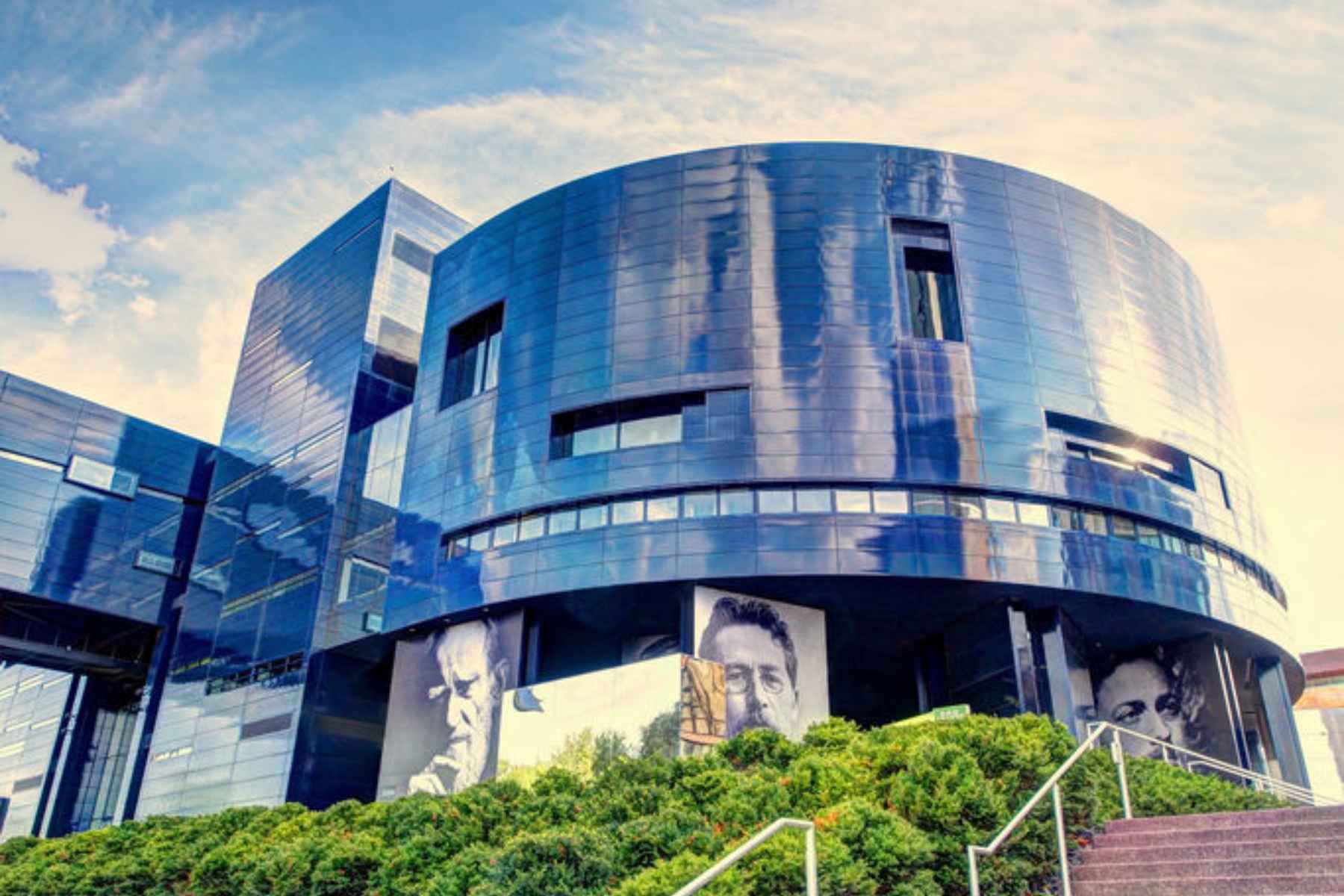Walking has always been my preferred way to explore new cities. It not only allows me to experience the unique atmosphere of a destination but also lets me discover its attractions while getting some exercise. When I choose a guided tour, it becomes a triple benefit!
Recently, I found myself in Minneapolis and wanted to learn more about the city. My previous visit was ages ago, and I barely remembered anything other than attending a show at the famous Guthrie Theater. To dive deeper into the city’s history and culture, I decided to take a tour with Minneapolis City & Skyway Tours.
Opt to Explore with Minneapolis City & Skyway Tours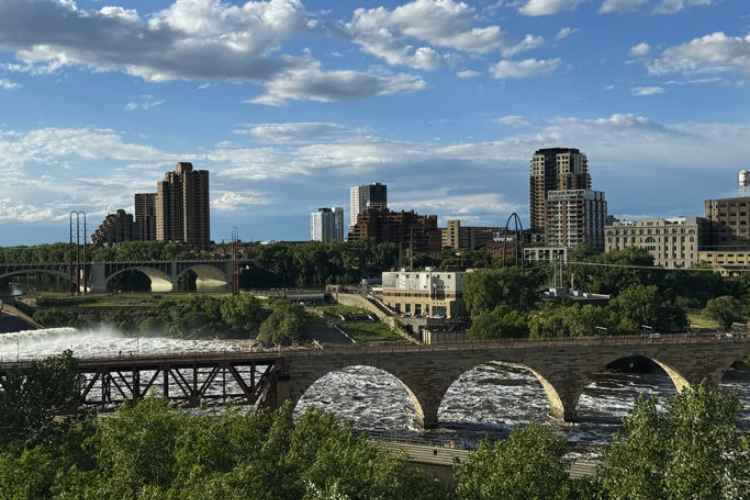
The company offers two main tours: the Minneapolis City Walking Tour and the Minneapolis Skyway Tour. The walking tour runs from May to September, while the skyway tour is available year-round. This makes it perfect for winter months when it’s too cold or rainy outside, or even during hot and humid weather.
Minneapolis is home to the largest contiguous skyway system in the world. Originally created in the 1950s to revitalize the city’s retail core after the suburban boom, the walkways now connect 80 city blocks and span over nine miles.
I booked an excursion with Minneapolis City & Skyway Tours, and their owner and guide, Jessica Schugel, offered to combine both tours so I could experience everything. She also mentioned that the skyway system contains many art and architectural gems that aren’t visible from street level.
Meet Jessica Schugel, Owner/Guide Extraordinaire
Schugel, who calls Minneapolis her home, has been leading tours for over a decade, both locally and abroad, including in Nicaragua, which she considers her second home. She believes in building personal connections through travel, saying, “It’s a big part of what makes life interesting.” Regarding Minneapolis, she adds, “There are so many people and places that make this city special, which is why I spend so much of my free time roaming the streets enjoying the familiar and in search of what’s new.”
Learn About the Storied History of the Foshay Tower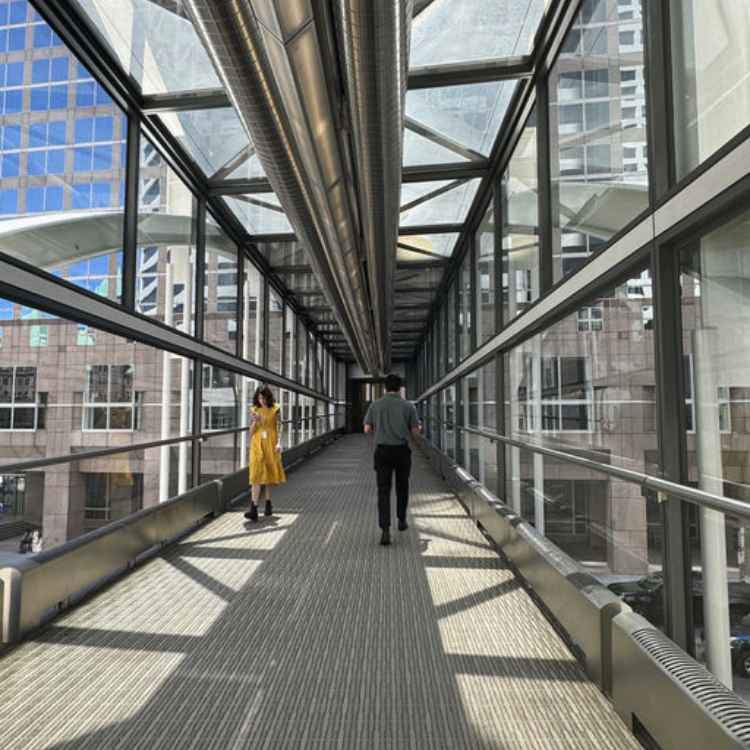
Our tour began at the Foshay Tower, completed in 1929 and modeled after the Washington Monument. This Art Deco masterpiece is one of the most recognizable structures in the Twin Cities. Standing at 447 feet tall with 32 stories, it was the tallest building in the Midwest for 48 years and has been on the National Register of Historic Landmarks since 1978.
Designed by architect Leon Eugene Arnal for utility business magnate Wilbur Foshay, the building features African mahogany, Italian marble, terrazzo tile, silver-and-gold-plated ceilings, elaborately embellished doorways, and cathedral-style light fixtures. Foshay’s name is carved in ten-foot-high letters on all four sides of the limestone pyramid.
The tower’s history is “part Greek fable, part Citizen Kane,” telling the story of the rise and fall of a powerful tycoon. Foshay, fascinated by the Washington Monument, proposed building a tribute in Minneapolis to himself and his success. However, the stock market crash of 1929 led to his downfall, and he eventually went to prison. Today, the tower houses the W Hotel and includes a museum and an observation deck on the 31st floor with 360-degree views of the city.
Head into the IDS Center, the Tallest Building in the City
Along the same street is the currently tallest building in Minnesota, the IDS Center. Completed in 1972, it stands 792 feet tall and is at the heart of the downtown Skyway system. It includes nearly two million square feet of mixed-use space, a retail center, a nineteen-story luxury hotel, and an award-winning, enclosed, eight-story urban park called Crystal Court.
Nearby is the RBC building, another vertical skyscraper in the city’s core. This contemporary, forty-story structure includes office space, condos, the Four Seasons Hotel, and restaurants. It opened just two and a half years ago and is considered the new kid on the block.
Best Minneapolis-Saint Paul Tours & Excursions
Check Out “Fallen Man II”
Schugel led us downstairs, where Viola Frey’s sculpture, “Fallen Man II,” sits alone. Frey was an American sculptor known for her larger-than-life monumental ceramic figures of men in power suits and women clothed in 50s fashion or dressed in pink in their birthday suits. We commented on how unfortunate it is to have a work of art by a celebrated sculptor in a place where not too many people see it.
Another Art Deco masterpiece is the old Farmers and Mechanics Savings Bank, now the Westin Hotel. Built in 1942, this handsome structure is also on the National Register of Historic Places. I was delighted to see that several aspects of the original building were kept intact and have new uses, such as the teller counter, now a bar, and the safety deposit vault, serving as a wine cellar.
Read More: 7 Top Lakeside Vacation Spots in the United States
Aviator Rufus R. Rand Leaves His Mark on the Rand Tower
The Rand Tower is an additional example of the ornate Deco style of the Jazz Age. Designed by WWI aviator and daring adventurer Rufus R. Rand Jr., the building, now a boutique hotel, has a prominent aviation theme inside and out. Aviation-inspired artwork lines the walls, and stars and silver moons dot some floors.
“Hanging Stones” Takes Center Stage at U.S. Bank Plaza
U.S. Bank Plaza, initially called Pillsbury Center, is notable for its marble towers with bronze-tinted reflective windows. One is 21 stories tall, and the other 40. They’re connected by a large atrium lit naturally by a dramatic glass ceiling.
Hanging down into this open area is Loren Madsen’s giant V-shaped sculpture titled “Hanging Stones.” It’s very eye-catching, and at first glance, it appears carved from a single piece of black granite. As we got closer, however, we realized it was 276 separate pieces, individually suspended by cables from above.
Artwork Abounds in the Capella Tower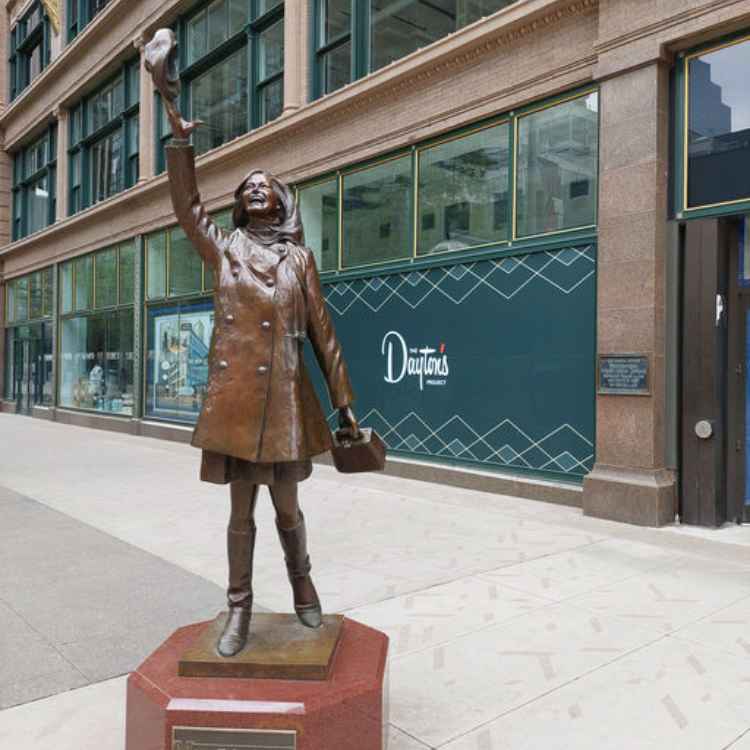
One of my favorite buildings is the Capella Tower due to the treasure trove of artwork inside. “Capella Basket” is the attention-getting centerpiece of the building. Artist Jason Krugman blended craft with technology to create this fantastic work, comprised of over 10,000 circuit boards that distribute and deliver power to nearly 2,000 LED light sources. Measuring 22 feet by 22 feet by 16 feet and hanging seventy feet in the air, it appears to float within the large glass-walled atrium.
“Fresnel Wing” by James Carpenter is another impressive structure in the Tower. It hangs from the ceiling on the skyway level and is constructed out of aluminum, stainless steel, and glass panels. Each of the 56 panels ranges in hues of pastel yellow to pink. The color comes from the lights aimed at the panels, but a special coating diffuses the color. I was enchanted with the hue alterations.
Also within the Capella Tower is an array of Dale Chihuly glasswork. The series of bowls, entitled “Macchia Forms,” are set within their own lit cases. In typical Chihuly style, the pieces shimmer with vibrant colors—green, pink, purple, and blue—and have the look of something organic from the sea.
Discover the Wonders Inside City Hall and Courthouse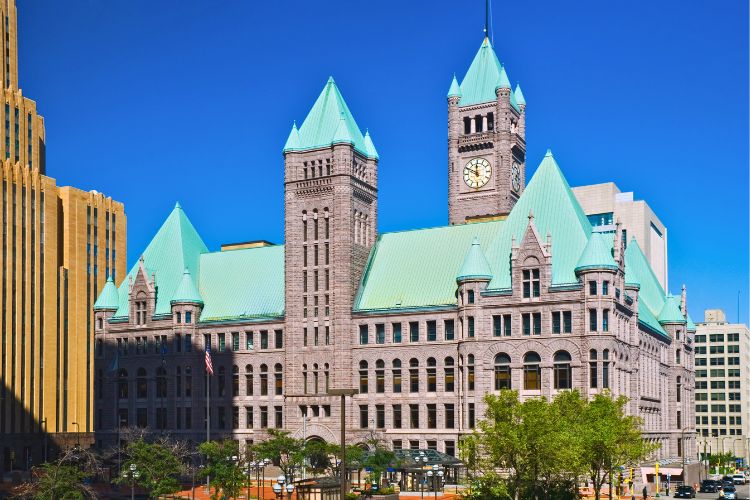
Minneapolis City Hall and Courthouse are both historic beauties. Built between 1887 and 1906 and designed by Long and Keys Architects, it’s an elegant and grand building noted for its Richardsonian Romanesque architecture. It boasts stained glass windows, carved Italian marble, an impressive vestibule, and a majestic five-story rotunda.
At the center of the rotunda is “Father of Waters,” a massive sculpture by Larkin G. Mead, made from what was then the world’s largest block of marble. The marble came from the same quarry that Leonardo da Vinci and Michelangelo used for their materials. Good luck is said to go to whoever rubs the sculpture’s big toe. And yes, you bet I rubbed it!
It turns out the statue was originally made for New Orleans, but when that town failed to raise the money, some good folks from Minneapolis bought it and moved it here in 1904. All the elements of the sculpture fit with the city’s Mississippi River connection, but one—the alligators!
The clock tower at City Hall is also notable, as when it was installed, it was the largest in the world. The bells were initially played by pressing gigantic wooden levers in the tower. Now, they’re played from a keyboard situated in the Rotunda.
Then there’s the Hennepin County Government Center. Its central piece of art is a sizeable reflecting pool and fountain. Water arches out of mill machinery pieces that look like cannons. The mill theme is apt, as Minneapolis was built on the milling industry.
Migration Is the Theme of a Special Artwork in the Public Service Center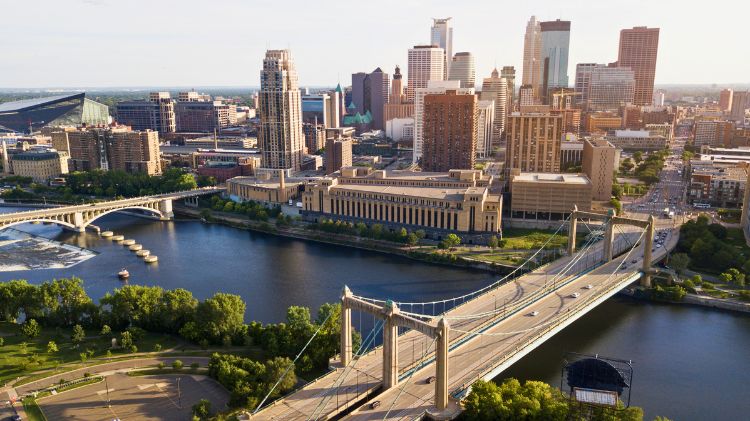
One of the most unique art installations is in the Minneapolis Public Service Center. “Lines of Flight, Human,” by Futures North, looks like Morse Code with dots and dashes. Learning that the work was inspired by the history of human migration to the region fascinated me.
Information about the installation says it “visualizes U.S. Census demographic data as woven bands creating an interconnected network, and each band corresponds to the migration of a different population and grows denser during periods of increased migration.” You can follow the work as it continues along the windows of the skyway bridge from the Service Center to the Hennepin County Courthouse.
Best Hotels in Minneapolis
Get Your Work Done on the Original Trading Floor of the Grain Exchange
The Grain Exchange is another highlight. Intricate stonework outlines the exteriors of the trio of structures, and a marble staircase is featured in the Main Building Lobby. Built in 1903, it was one of the first steel structures in the city and featured the historic trading floor, home to the much-prized Hard Red Spring Wheat market. Throughout the years, buyers and sellers worked to expedite grain from the farm to the consumer’s table.
This trading floor is now a cooperative workspace but retains the original trading board, its handsome Palladian windows, its 42-foot ceiling, and other fantastic, classical architecture components.
Sculptures dot the downtown sector, and as we walked, Schugel pointed out several pieces, including the Mary Tyler Moore bronze, “Rockman” and “Dancers.”
Mary Tyler Moore Is Immortalized
The Mary Tyler Moore statue, created by sculptor Gwendolyn Gillen, is a popular attraction with fans, tourists, and locals. It captures the immortal moment when Mary throws her hat in the air during the opening credits of the 1970s hit TV show. This sitcom put Minneapolis on the map.
Whimsical “Rockman” Holds Court Outside the U.S. Courthouse
The “Rockman” statues by Tom Otterness add a whimsical vibe to the front of the U.S. Courthouse. The tall piece looks like a pile of rocks, but look closely, and you’ll see little minions hiding among the stones. More can be found scattered throughout the courthouse plaza. Even the groundskeepers are minions!
“Dancers” is the work of Colombian artist Fernando Botero, known for his style of depicting people in large, exaggerated volumes. Though exaggerated, the figures are sensual. Fun fact about Botero: He discovered art when he gave up the idea of becoming a bullfighter. He found he preferred painting and drawing bulls rather than fighting them.
Explore the City’s Mill History
Toward the end of the tour, we headed down to the riverfront where Mill City is located. This architectural showpiece rises eight stories within the limestone ruins of the Washburn A Mill. Minneapolis was once the “Flour Milling Capital of the World,” powered by the mighty Mississippi and supplied by trains full of boxcars carrying grains from the plains.
Inside Mill City is a museum where you can explore antique milling equipment, vintage advertising, and tales from the wheat farms. Schugel told us the ruins area is an open-air courtyard often used for special events and concerts.
Famed Guthrie Theater Is an Architectural and Cultural Gem
Nearby is the Guthrie Theater, an internationally recognized performance hall with three state-of-the-art stages, production facilities, classrooms, restaurants, and public lobbies. Designed by prize-winning architect Jean Nouvel, the Guthrie was founded in 1963 by Sir Tyrone Guthrie. It’s a beloved landmark in the city, with an audience attendance of over 300,000 annually.
The Guthrie sits on land overlooking the Mississippi on one side and the Minneapolis skyline on the other. Within the theater are many fantastic spaces, with the “Endless Bridge” being one of the building’s most stunning architectural features.
A 178-foot cantilever protrudes from the side of the structure, carrying guests out to picturesque landscape views. Equally beautiful views can be seen from the Dowling Studio Lounge. This captivating space shows off the scenery through yellow-tinted, floor-to-ceiling windows, infusing the area with warm colors.
Many famous actors have worked at the Guthrie, including Hume Cronyn, Jessica Tandy, Ian McKellen, Mahershala Ali, Morgan Freeman, Elizabeth Banks, and more. Several of these individuals started at the Guthrie before heading to the bright lights of Broadway.
Seeing a performance at the Guthrie is a real treat and a must for visitors who want to experience the theater in its entirety.
Stroll with a View
We finished the tour by strolling along the Boardwalk, a popular place for locals and visitors to get their steps, along with great views of St. Anthony Falls. This is the only natural, major waterfall on the Mississippi River. It was named by Father Louis Hennepin, the first white person to encounter the waterfall in 1680. He called it for his patron saint, Anthony of Padua.
Throughout this excursion, Schugel engaged us with pertinent information and entertaining stories. Her enthusiasm for her hometown is infectious, and it’s clear she takes pleasure in sharing her knowledge with others. Though we covered much ground (and skyways!), she emphasized that there was so much more to be seen in this fascinating destination.
Need a hand planning your trip? Here are the
sites and services
we rely on most, from booking tools to travel products we love.
Inspire your next adventure with our articles below:
Explore Split Rock Lighthouse: One of Minnesota’s Most Iconic Landmarks
Why You Should Visit Door County, Wisconsin This Winter
Want to discover more hidden gems and helpful travel tips? Join our free newsletter for the latest travel secrets and travel articles.
We are reader-supported and may earn a commission on purchases made through links in this article.

